
Eucalyptus is a genus of more than 700 species of flowering plants in the family Myrtaceae. Most species of Eucalyptus are trees, often mallees, and a few are shrubs. Along with several other genera in the tribe Eucalypteae, including Corymbia and Angophora, they are commonly known as eucalypts. Plants in the genus Eucalyptus have bark that is either smooth, fibrous, hard or stringy, the leaves have oil glands, and the sepals and petals are fused to form a "cap" or operculum over the stamens. The fruit is a woody capsule commonly referred to as a "gumnut".

Eucalypt is any woody plant with capsule fruiting bodies belonging to one of seven closely related genera found across Australia: Eucalyptus, Corymbia, Angophora, Stockwellia, Allosyncarpia, Eucalyptopsis and Arillastrum. In Australia they are commonly known as gum trees.
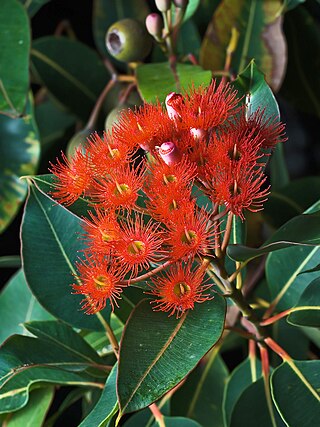
Corymbia, commonly known as bloodwoods, is a genus of about one hundred species of tree that, along with Eucalyptus, Angophora and several smaller groups, are referred to as eucalypts. Until 1990, corymbias were included in the genus Eucalyptus and there is still considerable disagreement among botanists as to whether separating them is valid. As of January 2020, Corymbia is an accepted name at the Australian Plant Census.

Corymbia ficifolia, commonly known as red flowering gum, is a species of small tree that is endemic to the south-west of Western Australia. It has rough, fibrous bark on the trunk and branches, egg-shaped to broadly lance-shape adult leaves, flower buds in groups of seven, bright red, pink or orange flowers and urn-shaped fruit. It has a restricted distribution in the wild but is one of the most commonly planted ornamental eucalypts.
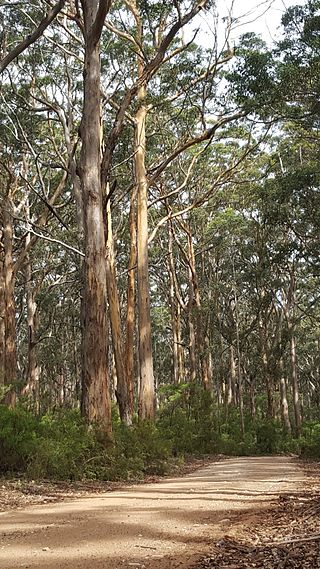
Eucalyptus diversicolor, commonly known as karri, is a species of flowering plant in the family Myrtaceae and is endemic to the south-west of Western Australia. It is a tall tree with smooth light grey to cream-coloured, often mottled bark, lance-shaped adult leaves and barrel-shaped fruit. Found in higher rainfall areas, karri is commercially important for its timber.

Eucalyptus cladocalyx, commonly known as sugar gum, is a species of eucalypt tree found in the Australian state of South Australia. It is found naturally in three distinct populations - in the Flinders Ranges, Eyre Peninsula and on Kangaroo Island.
Currency Creek is a township and locality in South Australia on the western shore of Lake Alexandrina about 6 km north of Goolwa, beside a seasonal stream bearing the same name – Currency Creek – which flows into Lake Alexandrina. The locality includes the headland named Finniss Point which separates the mouths of Currency Creek and the Finniss River.

Eucalyptus fasciculosa, commonly known as pink gum, hill gum or scrub gum, is a species of small tree that is endemic to southern Australia. It has mostly smooth, light grey to pinkish bark, lance-shaped adult leaves, flower buds in groups of seven, white flowers and conical to barrel-shaped fruit.
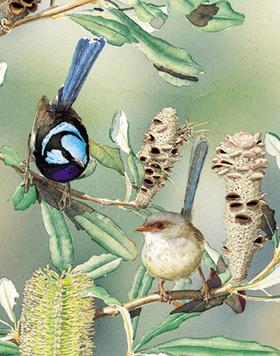
Ian Thomas Roberts is a nationally recognised Australian bird and native vegetation painter; he is a co-director, with his wife Narelle, of the Medika Gallery (Blyth).
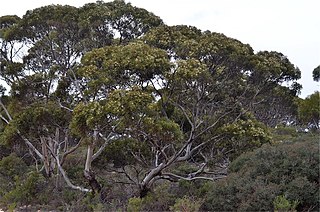
Eucalyptus gracilis, commonly known as yorrell, snap and rattle, red mallee, white mallee or kong mallee, is a species of mallee or small tree endemic to Australia, where it is found in south-western New South Wales, Victoria, South Australia and Western Australia. It has smooth white bark, usually with rough, fibrous or flaky bark on the lower stems, linear to narrow lance-shaped adult leaves, flower buds in group of between seven and eleven and cup-shaped, cylindrical or barrel-shaped fruit.

Eucalyptus socialis, commonly known as the red mallee, or grey mallee, is a species of mallee that is endemic to inland Australia.
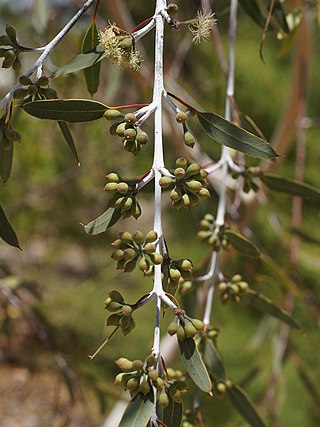
Eucalyptus pendens, commonly known as the Badgingarra weeping mallee, is a mallee that is native to a small area on the west coast of Western Australia.

Eucalyptus sparsa, commonly known as the northern ranges box, is a species of mallee that is endemic to inland Australia, near the border between the Northern Territory, South Australia and Western Australia border. It has smooth pale grey and brown bark, often with rough bark on the base of larger trunks, lance-shaped adult leaves, flower buds usually in groups of seven, white flowers and shortened spherical to conical fruit.
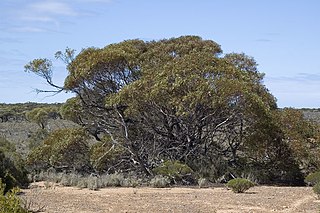
Eucalyptus yalatensis, commonly known as the Yalata mallee, is a species of mallee or a shrub that is endemic to southern Australia. It has rough, fibrous or flaky bark on the stems, smooth bark above, lance-shaped adult leaves, flower buds mostly in groups of nine, creamy white or yellowish flowers and hemispherical to shortened spherical fruit.

Corymbia dunlopiana, commonly known as Dunlop's bloodwood, bongonyin, or Oenpelli bloodwood is a species of tree that is endemic to the Northern Territory. It has rough bark on the trunk and branches, a crown of sessile, juvenile leaves arranged in opposite pairs, flower buds solitary or in groups of three, red flowers and urn-shaped fruit.
Eucalyptus remota, commonly known as the Kangaroo Island ash, Kangaroo Island mallee ash, or Mount Taylor mallee, is a species of tree or mallee that is endemic to Kangaroo Island in South Australia. It has smooth bark, often with rough, fibrous bark on the trunk, lance-shaped adult leaves, flower buds in group of between nine and twenty one, white flowers and hemispherical or shortened spherical fruit.

Eucalyptus calcareana, commonly known as the Nundroo mallee or Nundroo gum, is a mallee or a small tree that is endemic to the south coast of Australia. It has smooth, greyish or cream-coloured bark, lance-shaped or curved adult leaves, flower buds in groups of seven or nine, creamy-white flowers and cup-shaped to conical fruit.

Eucalyptus arcana, commonly known as the Mallee manna gum or Carpenter Rocks gum is a mallee that is endemic to South Australia. It has rough bark from the base of the trunk to the thinnest branches, lance-shaped, sometimes curved leaves, flower buds in groups of seven, white flowers and hemispherical fruit. It is only known from a single population near Carpenter Rocks.
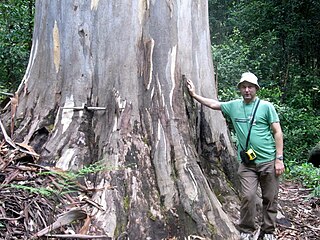
Dean Nicolle, is an Australian botanist, arborist and ecologist. He is widely recognised as the leading authority on the genus Eucalyptus.

The Cazneaux Tree, also known as Cazneaux's Tree, is a Eucalyptus camaldulensis or river red gum that was made famous by the photographer Harold Cazneaux. It is in the Australian state of South Australia in the locality of Flinders Ranges near Wilpena Pound. The tree is located within the boundaries of the Ikara-Flinders Ranges National Park on the west side of the Flinders Ranges Way about 3 kilometres (1.9 mi) north-east of the Wilpena Pound Resort.



















